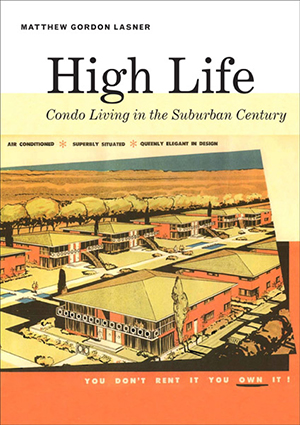- Home
- 2013 Cummings
2013 Cummings Award Winner
 Matthew Gordon Lasner
Matthew Gordon Lasner
High Life: Condo Living in the Suburban Century
Matthew Lasner's High Life: Condo Living in the Suburban Century (Yale University Press, 2012) is erudite, deeply researched, and highly original. Rather than limiting his focus to multifamily dwellings that take a specific physical form, Lasner analyzes the intent of the people who developed and lived in such dwellings, the financing of these buildings, how they were marketed by real estate developers, all the while privileging ownership as a distinguishing unifying factor. Lasner adeptly synthesizes what could have been a daunting tangle of mortgage reforms, financial regulation, landlord/tenant law, and real estate schemes into a coherent narrative about an understudied form of American housing.
The award committee's charge was to select the publication that best exemplifies the spirit of the awardundefineda work based on primary research, that breaks new ground in interpretation or method, and that contributes to the intellectual vitality of vernacular studies in North America. In terms of method, High Life includes within it a fundamental challenge to the field of vernacular architecture studies.
Lasner unites urban history, social geography, and economics to explain the development of a residential pattern that was exhibited in various built forms and in various locations throughout the United States. High Life is not a typical "building type study." Lasner does not define the structures in question by form (like a courtyard house or a skyscraper) nor are they defined by function (such as a museum, a summer camp, or a library). Instead, the type in this study, which includes both condominiums and co-ops, is defined by managerial organization and legal ownership. In some cases, home-owners held deeds to their own apartments, and in other cases, entire structures were owned collectively. Although the subject has gained little scholarly attention in vernacular architecture studies, condominiums are an ever-present part of the everyday built environment in nearly every city and in many suburbs. They are both ubiquitous and invisible.
Lasner writes with compassion about tenants, home-owners, and the many historical actors who promoted fair and open housing in spite of the developers and landlords who promised "social improvement through exclusion." His research illustrates the idealism that frequently is associated with co-ops and other forms of communal ownership and reveals the bigoted appropriation of architecture to serve discriminatory housing practices.
The committee members were especially impressed by the potential for further research suggested by Lasner's work. As he suggests in the epilogue, the history of co-owned housing might lead to new research on the liminal spaces and subjects that lie between the city and suburb, the single-family dwelling and the apartment house, the density of the core and the plasticity of sprawl. High Life challenges us to search outside well-traveled paths, and seek inspiration in unlikely places. Lasner writes with grace and ease, integrating finely-grained details about specific developments, people, and locales with grand themes of social history.
Carla Yanni
Chair, Abbott Lowell Cummings Award Committee